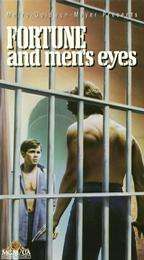Fortune and Men's Eyes
| Fortune and Men's Eyes | |
|---|---|
 VHS cover for the film | |
| Directed by | Harvey Hart |
| Produced by |
Lester Persky Lewis M. Allen |
| Written by | John Herbert |
| Starring |
Wendell Burton Michael Greer Zooey Hall Danny Freedman Larry Perkins James Barron Hugh Webster Tom Harvey Jan Granik Kirk McColl Vance Davis Robert Goodier Lázaro Pérez |
| Music by | Galt MacDermot |
| Cinematography | Georges Dufaux |
| Edited by | Douglas Robertson |
| Distributed by | Metro-Goldwyn-Mayer |
Release dates |
|
Running time | 102 minutes |
| Country |
Canada United States |
| Language | English |
| Budget | CAD 1,109,000 |
Fortune and Men's Eyes is a 1967 play and 1971 film written by John Herbert about a young man's experience in prison, exploring themes of homosexuality and sexual slavery. The title comes from William Shakespeare's Sonnet 29, which begins with the line "When in disgrace with fortune and men's eyes". It has been translated into 40 languages and produced in over 100 countries. It is the most published Canadian play, and won the Dominion Drama Festival's Massey Award in 1968, which Herbert refused,[1] and the Floyd S. Chalmers Canadian Play Award in 1975.
The play was inspired in part by Herbert's own experience; he spent four months imprisoned in a youth reformatory after having been convicted of wearing drag in 1947.[2] The character of Queenie in the play is an authorial self-insertion.[2]
Herbert encountered difficulties in getting the play staged. After being rejected by several directors, Herbert, on the recommendation of Robertson Davies, who frequented the University Club at which Herbert worked as a waiter, sent the script to Douglas Campbell at the Stratford Festival.[3] Campbell accepted the play for the festival's young actors workshop and assigned it to Bruno Gerussi to direct, but the Stratford Festival's board of directors forbade the production from being staged publicly.[4]
Herbert sent a copy of the play to renowned Canadian theatre critic Nathan Cohen, who replied, "I hope you understand that there's not a chance in the world of this getting a professional production in Canada. I've taken the liberty of sending it to a producer of my acquaintance in New York and, of course, promise nothing."[5] Cohen recommended the play to Broadway press agent David Rothenberg, who in turn recommended it to Dustin Hoffman. Hoffman workshopped the play at the New York Actors Studio in 1966, taking the role of Rocky, while Jon Voight played Smitty.[4]
In 1967 the play, produced by Rothenberg, premiered off-Broadway at the Actors Playhouse from 23 February 1967 to January 1968. Reviews were initially mixed, and many reviewers were shocked by the subject matter. Reviewer Herbert Whittaker wrote in The Globe and Mail that the play was "the art of washing our dirty linen in the neighbor's yard."[4] Cohen wrote in the Toronto Star that the play "lifts the carpet and shows what is underneath", and that "It asks deeply disturbing questions about long-established personal and social assumptions. It does not enrich our vision. It undermines it."[4]
The panel discussions held in conjunction with the play led to the creation of the Fortune Society, a New York City-based advocacy and support organization for former prisoners.[6][7][8]
The play toured to Chicago, San Francisco and Montreal and ran for 15 weeks at the Central Library Theatre in Toronto.[4]
In 1969, the play was produced and directed by Sal Mineo at the Coronet Theatre in Los Angeles. Don Johnson played the lead role of Smitty, a young man sentenced to six months in prison for marijuana possession, who eventually becomes the sexual subordinate of another inmate, Rocky. Michael Greer played the role of Queenie, Smitty's cellmate. This production garnered more critical approval.
In the 1971 film, directed by Harvey Hart, Wendell Burton played Smitty, Michael Greer reprised his role as Queenie, and Zooey Hall played Rocky. It was filmed in Quebec, Canada.
Movie Cast
- Wendell Burton as Smitty
- Michael Greer as Queenie
- Zooey Hall as Rocky
- Danny Freedman as Mona
- Larry Perkins as Screwdriver
- James Barron as Holy Face Peters
- Lázaro Pérez as Catso
- Jon Granik as Sgt. Gritt
- Tom Harvey as Warden Gasher
- Hugh Webster as Rabbit
- Kirk McColl as Guard Sullivan
- Vance Davis as Sailor
- Robert Goodier as Doctor
- Cathy Wiehl as Cathy
- Georges Allard as Fiddler
- Modesto as One-Eye
- Michel Gilbert as Young Prisoner
- Robert Saab as Piano Player
- A. Zevotouman as Drummer
References
- ↑ http://www.thecanadianencyclopedia.com/en/article/john-herbert/
- 1 2 John Herbert at the Canadian Theatre Encyclopedia.
- ↑ "That Man's Scope: John Herbert now". The Body Politic, Vol 10 (1973).
- 1 2 3 4 5 http://www.canadiantheatre.com/dict.pl?term=Fortune%20and%20Men%27s%20Eyes
- ↑ http://www.allangould.com/magazines/profiles/nathancohen/magazines_profiles_nathancohen.html
- ↑ http://www.nytimes.com/2001/06/27/theater/john-herbert-dies-at-75-wrote-of-prison-life.html
- ↑ http://fortunesociety.org/
- ↑ https://www.youtube.com/watch?v=_5okzdZA-OM
External links
- Fortune and Men's Eyes at the Internet Movie Database
- Fortune and Men's Eyes at AllMovie
- Fortune and Men's Eyes at Internet Off-Broadway Database
- Canadian Theatre Encyclopedia entry